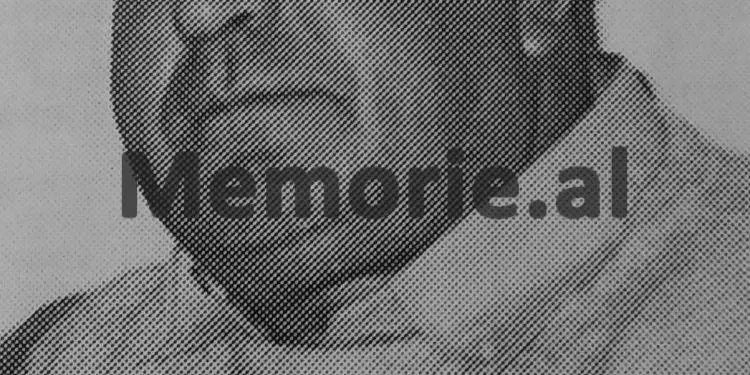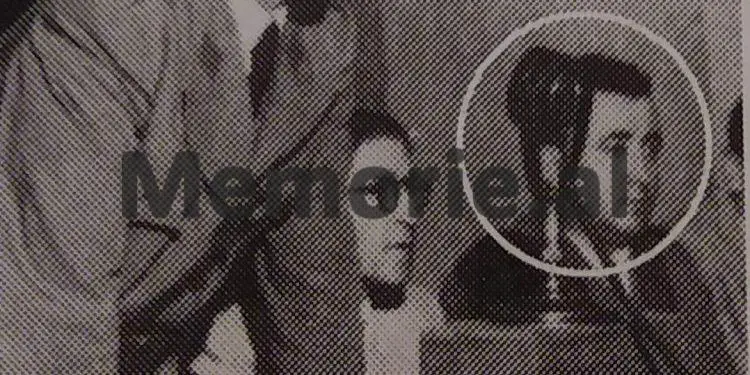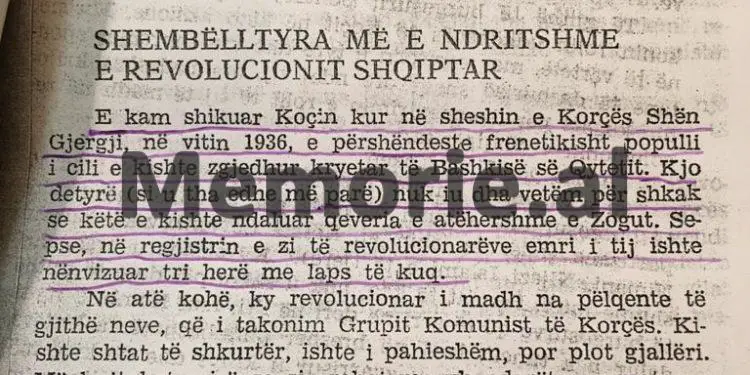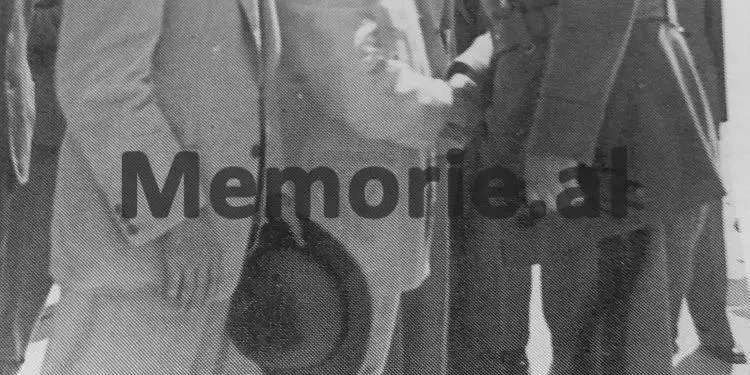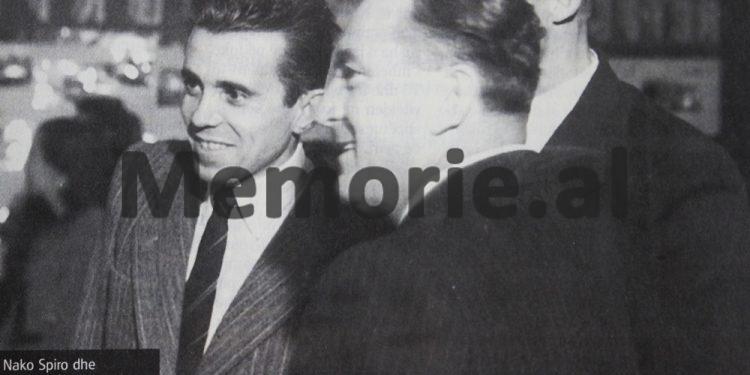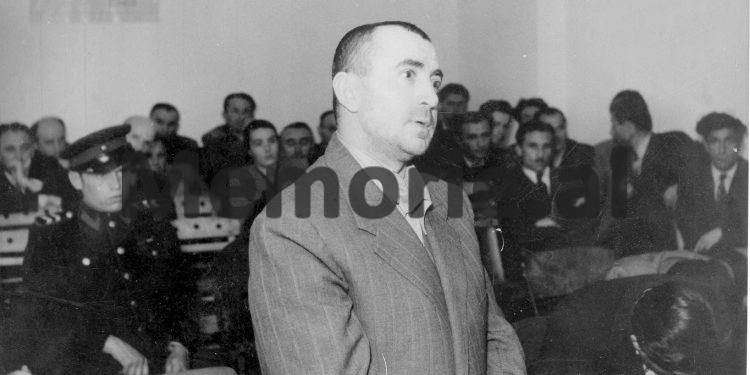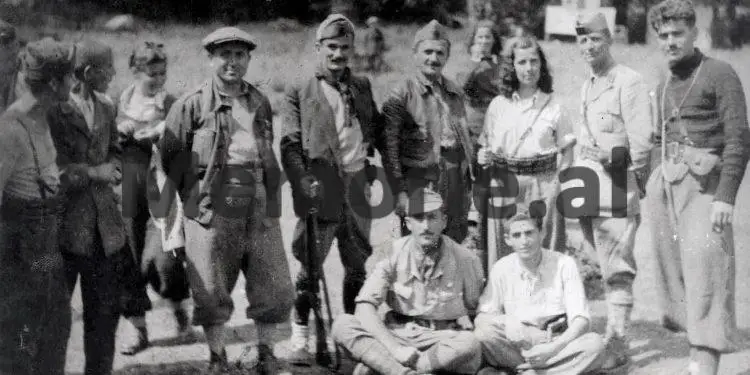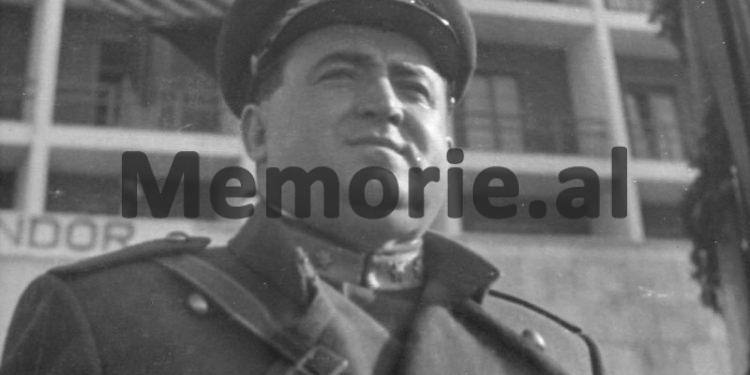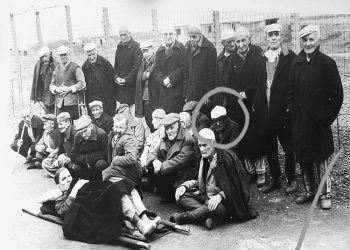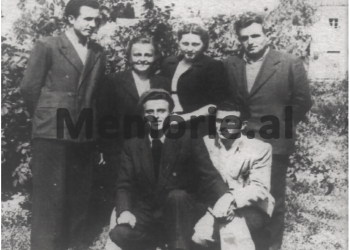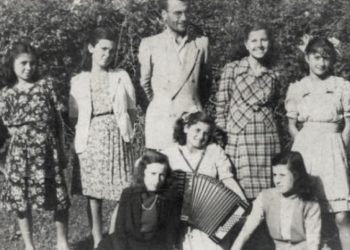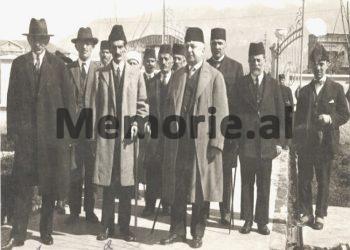Dashnor Kaloçi
Second part
Memorie.al publishes the rare and unknown story of Koçi Xoxe originally from Cologne, but born in 1911 in the village of Negovan in Florina, Greece, where their family had settled for economic reasons, who after studying and graduated with honors in the classical gymnasium of Thessaloniki in 1929, where he became acquainted for the first time with the communist ideas and literature of the Marxist-Leninist groups operating in Greece at that time, returned to the city of Korça, later becoming one of the founders of the first cell communist in Albania and vice-president of the Communist Group of Korça, since the early 1930s, chairman of the Society ‘Puna’ in 1936, where in the elections held that year, the people of Korça elected him as chairman of the Municipality, but was not allowed by the government of King Zog, as he had been arrested and imprisoned several times for communist activities. Koçi Xoxe’s participation in the founding meeting of the Communist Party of Albania in November ’41, (where he went a day late, because he was busy organizing the demonstration on November 7 of that year in the city of Korça where he remained killed the young communist, Koci Bako), where for his great contribution to the communist movement, he was elected in absentia, as a member of the Provisional Central Committee, and then as a member of the General Staff of the National Liberation Army since July 10, 1942 at the Labinot meeting, the delegate to the Përmet Congress on May 24, 1944, where he was awarded the rank of lieutenant general, and at the Berat meeting in October of that year, he was elected deputy prime minister headed by Enver Hoxha. Xoxa’s brilliant career immediately after the end of the War, climbing the ranks of the party and state hierarchy, as organizational secretary of the Albanian Communist Party, member of the General Presidency of the Democratic Front of Albania, member of the People’s Assembly, Minister of Internal Affairs and Deputy Prime Minister of the ‘democratic government’, being the number two figure of communist Albania, after Colonel-General Enver Hoxha. Unknown photos and rare testimonies of his two sons, Genc and Fatos, who for the first time shed light on the unknown history of their family and father, Koçi Xoxe, his relationship and relations with Enver, as well as the reasons the truth of his beating and physical elimination, as well as their tragic fate after 1949, when he was shot somewhere in a forest on the outskirts of Tirana (where the former Kinostudio “Shqipëria e Re” is located), where today his bones!
Followed by the last number
How did Koçi relate to Marxist communist groups in Greece?
According to the testimonies of his family, during the years that Koçi was a student of the classical gymnasium of Thessaloniki, he came into contact for the first time with communist ideas through various Marxist-Leninist groups operating in Greece. Also during those years and later under the influence of his fellow villager, Kacaranxa, Koçi read Marxist literature, such as the book “Mother” by Maxim Gorky and regularly listened to Radio Moscow. From this environment where he was molded and formed his character with leftist political convictions, he came to Albania in the summer of 1933 and settled in the city of Korça, (at the house of his father, Dhimitri, who at that time had opened a shop for sheet metal work and worked there himself), where he created the first communist cell in the city of Korça, which was the first in Albania. Influenced by the Marxist-Leninist districts of Greece, in addition to the first communist cell founded by Koçi Xoxe, which also included Miha Lako, Pilo Peristeri, Misto Treska, Sotir Vulkani, etc., at that time in that city, some other young people like: Aristidh Qëndro, Andrea Zisi, Zai Fundo, etc., created another communist faction, called the “Fire Group”. A part of these young people from Korça of both groups, who were the first to embrace the ideas of the communist left, were also influenced by Tajar Zavalai (who at that time was interned in the district of Korça by King Zog, due to his communist activity), who had translated Gorky’s novel “Mother” and given that book to them along with some communist pamphlets and literature, which had then entered Albania from Greece and Montenegro.
The return of Koçi to Korça and the creation of the communist cell
The arrival of Koçi Xoxa in the Communist Group of Korça, which was in fact a small cell, was well received not only by its ordinary members, but also by the main leaders, such as Miha Lako, PIlo Peristeri, Sotir Vulkani, etc. for Xoxe was considered an educated intellectual with clear visions of the communist movement, of the very formation and connections he had with the Marxist circles when he was a student of the classical gymnasium of Thessaloniki. He maintained these ties even after his arrival in Korça and expanded them further, connecting with Bulgarian and Romanian communist groups. At that time, Xoxe not only enjoyed the respect of the members and sympathizers of the communist cell of Korça, but he was known and respected as an intellectual throughout the city and beyond. He was the only member of the Communist Group who maintained constant contact with the village and especially with the intellectuals of the Muslim faith areas of that District. According to some testimonies from Xoxa’s contemporaries, who knew him closely, it is known that at that time, any intellectual who would go to the city of Korça, it was impossible not to seek to meet Koçi!
The election of Koçi, as mayor of Korça in 1936!
Seeing the great respect and popularity that Koçi Xoxe enjoyed throughout the city of Korça, even as president of the Society “Work” which he had founded himself, in the local elections held in 1936, the people of Korça voted and elected him to the post of mayor of that city, where at the end of the voting, he delivered a speech before the people of that city, thanking them for the trust they had given him. But the government of King Zogu, did not approve that candidacy, as he had been arrested and imprisoned several times, because of his communist activity and the law in force did not allow him to be elected to that position. In these circumstances, Koçi was allowed and remained only as a member of the municipal council of the city of Korça, which he exercised for several years. In this regard, after the ’90s, some elderly people in the city of Korça, have testified about the period that Koçi was a member of the municipal council, describing him as a man with a big heart, who tried to solve any problem that had the Hallejians knocking on the doors of that municipality. Around 1936, in the city of Korça, a big ceremony was organized by the city municipality in memory of the six martyrs who fell fighting in Orman-Çiflig. The main speech at that ceremony was given by Koçi Xoxe, who deeply touched almost all those present who were there, so much so that even today in Korça, it is remembered and said: “Like Koçi’s speech”. A great role in the defense of the city of Korça and its population, Koçi played in 1940 when the Italo-Greek war took place, where although he was no longer a member of the municipal council, together with a part of Korça intellectuals, got in touch with the senior military of the Greek army and especially with the Greek communists who fought in the ranks of that army, so that they would behave well in Korça and its villages, so that the population would not be affected and the city would be protected from destructions. And really thanks to that intervention, at that time by the Greek soldiers there were no extraordinary events or clashes with the locals and the city did not suffer destruction. The above, therefore, regarding the election of Koci Xoxa to the position of Mayor of Korça, as well as all his activity in the communist movement since the period of the Zog Monarchy and then during the Anti-Fascist War, has been confirmed by the general- Major Panajot Plaku, (former minister without portfolio in the government headed by Mehmet Shehu in the 60s, who fled Albania in 1958), in his book “Violence over the revolution in Albania”, (published first in Belgrade in 1966, where he was a political asylum seeker and then in Pristina in 1971), facsimiles of which we are publishing in this article.
How did Koçi connect with Enver Hoxha?
According to the testimonies of Fatos, Koçi’s son and his relatives, his father’s acquaintances with Enver Hoxha, have their origins in the early 1930s, when Koçi returned from Greece and settled in the city of Korça, where and formed the first communist cell. The friendship between them then consolidated when Enver approached the Communist Group of that city in the late ‘30s. In those years, for a long time Koçi was the vice-president of the Communist Group of Korça and then, with the arrival of Koço Tashko from Moscow, as the envoy of KOMINTERN, the activity of that group expanded greatly by increasing its ranks with members Young. Not only with Koçi who had a great contribution in the creation and consolidation of the ‘Communist Group’ of that city, but also with that of some other members, the role of Enver Hoxha in that group, was very minimal, so much so that then, Miha Lako and Pilo Peristeri, insisted that Enver not be accepted as a member of that communist group, due to the morally bad behavior he had, starting from the suicide of a girl from Korça, which happened after he was abandoned by Enver . Likewise, the great anti-fascist demonstration of November 8, 1941, which took place in the city of Korça (where the young communist Koci Bako was killed), was organized by Koçi Xoxe, but the official historiography of the pre-90s , deleted it and his name was never mentioned as its main organizer. This is confirmed by the fact that Koçi, being in the city of Korça with the organization of that demonstration, could not manage to participate in the first day of the founding meeting of the Albanian Communist Party in Tirana on November 8, ’41, which he admitted from Enver Hoxha himself in his memoirs, where he says that: “çi Koçi came a day late to the founding meeting of the Communist Party…”. Seeing the great contribution that Koçi had in the establishment and organization of the Communist Group of Korça, by the participants of the founding meeting of the SNP on November 8, 1941, he was elected a member of the Provisional Central Committee, and Enver Hoxha in that meeting was charged the duty of party financier.
How was Koçi arrested by the Italians in Tirana?
It is already known that from the founding meeting of the Albanian Communist Party on November 8, ’41, until the autumn of 1942, onwards, some of the leading communists who were expected or pretended to be appointed were eliminated or killed or imprisoned. at the head of the Communist Party, as it is already known, the post of its General Secretary, was left vacant and would be elected later, based on the merits of those who would be elected to that post. Thus, during this period of time after the founding meeting of the SNP, the first to be eliminated was Qemal Stafa, the main contender for the Party leader and for that assassination from that time onwards (mainly after the 1990s). , there were many suspicions and Enver Hoxha himself was accused of being implicated in that event. Also after Qemali, on October 11, 1942, in a communist base in the house of Ije Farka in Tirana, Vojo Kushi, Sadik Staveleci and Xhorxhi Martini were killed, and the fourth person who was present was captured alive by the Italian authorities there, Muharrem Llanaj, who fought to the end with Vojon. On that basis, shortly before the imposition of the siege, it was Enver Hoxha and by many old communists (such as brothers Hamit and Isuf Keçi, etc.), Enver was accused of having a hand in their murder. This is related to the fact that Enver aimed at the elimination and disappearance of Sadik Stavelec, one of the main leaders of the Communist Youth Group in Tirana, who was seen and was one of the main contenders to take the place of the party leader. Before their assassination took place, in April 1942, Koçi Xoxe, who was then the Organizing Secretary of the SNP, was also arrested by the Italians. Koçi’s arrest took place after the meeting he had with Enver Hoxha a few days ago, where Enver, after calling him, told him that he should no longer stay in illegality, after leaving the first prison, (where he had entered from the end of 1941), as this would further increase suspicions about him. “In order not to be noticed by the spies”, Enver suggested to Koçi that he open a barracks near Durrës Street and practice the craft of the tinsmith, which he knew and had learned from his father, since Korça. When Koçi, with the help of Andon Deçkë, was finishing setting up the barracks, the Italians came and arrested him. Thus, Koçi ended up in the Tirana prison again and was able to get out of there, only after the action of the explosion of that prison, which was carried out by the guerrilla units of Tirana led by Myslym Keta, Beqir Balluku, Adnan Qatipi, etc. (This event is also treated in the movie “Guerrilla Unit”, of the former Kinostudios “Albania e Re” since the late ’60s). After being released from prison, Koçi went to the area of Çermenika, where he was elected a member of the General Staff of the National Liberation Army since the meeting of July 10, 1943. The elimination of the main contenders for the leader of the Albanian Communist Party did not end with Koci Xoxen, but he continued further by Enver Hoxha, who ordered the elimination (shooting) of the two main leaders of the Communist Youth Group, Anastas Lula and Sadik Premtja, whereas is already known, Anastasi was shot on March 12, 1943 by a partisan unit led by Orhan Frashëri (in Qafën e Gllave, a place between Berat and Tepelena), while Sadiku was forced to flee Albania to the end of 1944, after he had escaped two assassinations ordered by Enver Hoxha. The series of eliminations of the main leaders of the Albanian Communist Party, or those who were seen as contenders for its leader, would continue further by Enver Hoxha, with Zef Malë, but his (Enver) order, which read that: … It should be decorated with a crescent bullet “, was not implemented by Gogo Nushi when they were in Peza! Memorie.al
The next issue follows




